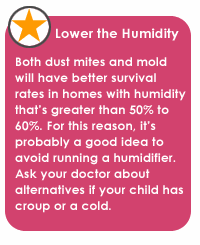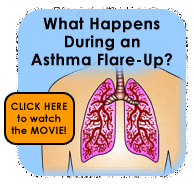Creating an Asthma-Safe Home
Article Translations: (Spanish)
If your child has asthma, you can create the best home environment possible by knowing which asthma triggers are at work and eliminating or minimizing exposure to them.
Your doctor can help you identify the triggers, which might include common stuff like dust mites and pollen.
Improving Indoor Air
Maintaining good indoor air quality in your home is an important aspect of asthma management. Irritants such as tobacco or wood smoke, perfumes, aerosol sprays, cleaning products, and fumes from paint or cooking gas can trigger flare-ups. Even scented candles or fresh newsprint are triggers for some people with asthma.
To maintain good air quality inside your home:
- Don't allow people to smoke in your home. If you smoke, quit or smoke outside.
- Avoid wood fires.
- Avoid scented products. Wash and dry clothes with unscented laundry detergent, fabric softeners, and dryer sheets. Use unscented or nonaerosol versions of household cleaning products and avoid scented candles or room fresheners.
- Make sure that all gas appliances vent to the outdoors.
- Choose an artificial tree for the holidays.
- Run the air conditioning, especially on days with high pollen or mold counts or ozone or pollution warnings.
- When buying a home, consider one with baseboard or radiant heating. Forced-air systems can foster mold and dust mites. If your home has a forced-air system, consider sealing off the vents in your child's bedroom with aluminum covers and tape.
- Clean all air ducts in the house and change the filters in your furnace and/or air conditioning system regularly.
- If you must open windows on days when the pollen count is high, do so after midmorning because counts are usually highest from 5 a.m. to 10 a.m. If air quality is the problem, open doors and windows early, before pollution has a chance to build up.
If you take these steps, but are still concerned about your home's air quality, consider buying an air cleaner with a HEPA (high efficiency particulate air) filter for your child's bedroom or playroom. Central air filtration systems are also an option, but are much more expensive.
Dealing With Dust Mites
Dust mites, a very common asthma trigger, are microscopic bugs that live in household dust. Their diet consists primarily of shed human skin cells. They're especially plentiful in upholstered furniture, on some kinds of bedding, and in rugs. The highest concentration of dust mites in the home is usually found in bedrooms.

To reduce dust mites:
- Vacuum and dust your home (especially your child's room) often — at least once a week. Use a special small-pore filter bag on your vacuum or buy a vacuum with a HEPA filter. When you dust, use a damp cloth to avoid spreading dust mite particles in the air.
- Avoid feather or down pillows or comforters; choose bedding made with synthetic materials instead.
- Every few weeks, wash all of your child's bedding in hot water (higher than 130°F or 54.4°C) and then dry it on a high setting.
- Cover mattresses, pillows, and box springs with mite-proof covers (available at many large retail stores and also online). Also, be sure to regularly wipe down the covers.
- Remove any carpeting, especially wall-to-wall carpeting, from your child's room and other spaces where he or she spends a lot of time.
- If you have area rugs, make sure they're washable and clean them weekly in hot water.
- Make sure window coverings in your child's room can be washed or cleaned easily. Stay away from blinds, which have lots of horizontal surfaces that catch dust, or fancy curtains with lots of folds, which have to be dry cleaned. Wash all window coverings regularly.
- Avoid upholstered furniture and pillows.
- Clean up the clutter in your home. Clear away knickknacks, picture frames, and plants that collect dust.
- Store most of your child's books in a room other than his or her bedroom or playroom.
- Keep your child's collection of stuffed animals to a minimum. Any plush toys that your little one just can't live without should be washed often in hot water (if they don't contain batteries) and then dried on your dryer's highest setting. You also can seal these toys in a plastic bag and put them in the freezer for at least 5 hours or overnight (dust mites can't survive more than 5 hours of freezing temperatures).
- Avoid using a humidifier, especially in your child's room.
- Run a dehumidifier in the basement or other damp areas of your home. But make sure you empty and clean the water pan often.
Minimizing Mold
Molds are microscopic plant-like organisms. They can grow on many surfaces, and flourish in damp places like bathrooms and basements. Molds reproduce by sending spores into the air; inhaled mold spores are a common asthma trigger.
To reduce moisture and mold:
- Fix leaky pipes, faucets, or roofs. Clean and repair roof gutters regularly.
- Make sure your bathrooms and basement are well ventilated. Install and use exhaust fans to help lower moisture in these areas.
- If you have any damp closets, clean them well and leave a 100-watt bulb on all the time to increase the temperature and dry out the air.
- Run a dehumidifier in the basement or other damp areas. Again, it's important to empty and clean the water pan often.
- Remove wallpaper and wall-to-wall carpeting from bathrooms and basement rooms.
- Run the air conditioning (this is especially helpful if you have central air), making sure to change the filter monthly.
- Avoid houseplants, which may harbor mold in their soil.
- Clean any visible mold or mildew with a solution that's one part chlorine bleach to 10 parts water. Don't paint or caulk over moldy surfaces without cleaning them first.
- When painting bathrooms or other damp areas of your house, use anti-mildew paint.
- If there's visible mold on ceiling tiles, remove and replace them. Also check to see if there's a leaky pipe that may be causing the problem.
- Replace or wash moldy shower curtains.
Reducing Triggers From Animals and Cockroaches
Animals are a significant asthma trigger — as many as 30% of people with asthma are allergic to one or more animals. Allergic symptoms are caused by the body's reaction to a specific protein found in the animal's saliva, urine, or dander (tiny flakes of dead skin).
Animal hair itself does not cause allergies, but it can collect mites, pollen, and mold. And any animal that lives in a cage, from birds to gerbils, will produce droppings that can attract mold and dust. If you have a pet and your child is allergic to it, your best bet is to find the animal another home.
Short of getting rid of a pet, try these steps (though they're less effective):
- Keep pets outside. If you can't, at least keep them out of your child's bedroom and playroom.
- Wash and brush your pet every week.
- Make sure your child doesn't play with or touch your pet and keep him or her away from the litter box if you have a cat.
- Wash your hands after touching your pet.
- If you have a pet that lives in a cage, keep it in a room that your child doesn't spend time in regularly. Also, have someone other than your child clean the cage daily.
Cockroaches are another major asthma trigger that can be difficult to avoid in multifamily dwellings, especially in urban areas.
To avoid cockroaches:
- Have your home professionally exterminated every few months. Between professional treatments, use bait traps to catch roaches (avoid aerosol sprays, which can aggravate asthma).
- Avoid saving boxes, paper bags, or newspapers in piles around your home.
- Don't leave open food or dirty dishes lying around your kitchen.
- Keep counters free of crumbs or spills.
- Keep garbage containers closed.
- Wash recyclables before putting them in the bin.
More on Asthma Management
Trigger-proofing your home can seem overwhelming, especially if your child has multiple triggers. And the fact is, you won't be able to eliminate all triggers. Although you want your home to be safe for your child, you can't wrap it in a bubble.
Your doctor can help you decide which steps are necessary. But here are five tips to try to reduce asthma triggers:
- Put mattress covers on any bed your child sleeps in.
- Get rid of carpeting.
- Reduce dust.
- Get rid of any pest infestations.
- Don't permit smoking anywhere in your home.
Reducing triggers in your home — when combined with the rest of your child's asthma action plan (which might involve regular medicine and allergy shots) — can help your child breathe better and have fewer flare-ups.
Indeed, one study showed that when steps were taken to eliminate dust mites, kids with this trigger had fewer asthma symptoms, needed their quick-relief medicine (also called rescue or fast-acting medicine) less often, and were generally less sensitive to their other triggers.
Note: All information is for educational purposes only. For specific medical advice, diagnoses, and treatment, consult your doctor.
© 1995-2024 KidsHealth ® All rights reserved. Images provided by iStock, Getty Images, Corbis, Veer, Science Photo Library, Science Source Images, Shutterstock, and Clipart.com


